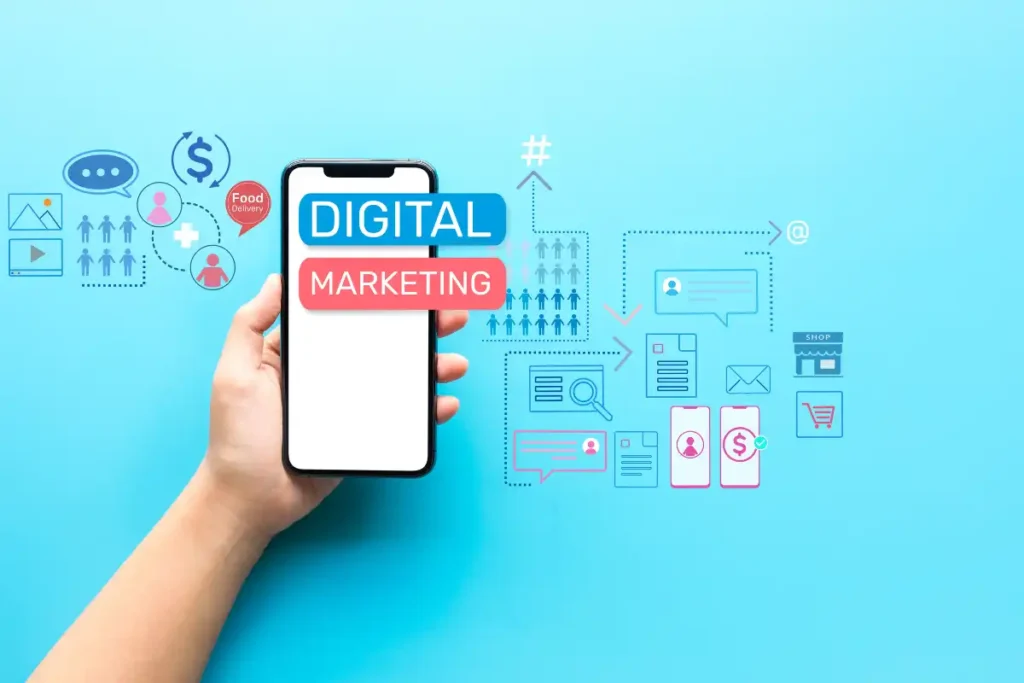The Importance of Effective Online Marketing for Local Businesses
The digital age has transformed the way consumers find, connect with, and support local businesses. Online marketing is no longer optional; it is essential for thriving in today’s market.
When done effectively, online marketing can help local businesses reach more customers, increase brand visibility, and foster community trust.
In this guide, you’ll learn step-by-step strategies for marketing your local business online to achieve sustainable growth and stay competitive.
1. Understand Your Target Audience
Define Your Ideal Customer Profile
Understanding your target audience is the first step to successful marketing. Start by developing a detailed profile of your ideal customer. Consider demographic data such as:
• Age, gender, and income level
• Geographic location
• Interests, values, and behaviors
• Purchasing patterns and needs
Gather data by analyzing past customer interactions, sales records, and surveys. Use customer feedback to identify pain points, preferences, and purchasing triggers.
Conduct Market Research
Market research helps you understand your competitors and industry trends. Here are a few methods to get started:
• Competitor Analysis: Identify your top competitors and study their online presence. Examine their website design, content, social media activity, and customer reviews.
• Industry Trends: Keep track of market changes, emerging customer preferences, and new technologies that could impact your business.
• Surveys and Feedback: Conduct surveys with existing customers to learn what they like about your products/services and where you can improve.
By understanding your target audience, you can tailor your marketing efforts to attract and retain the customers who are most likely to benefit from your offerings.
2. Build and Optimize Your Local Business Website
Mobile-Friendly and User Experience Focus
In today’s mobile-first world, it’s critical to have a website that works well on mobile devices. A mobile-friendly website is easy to navigate, loads quickly, and provides an excellent user experience on all screen sizes. Why this matters:
• Mobile Traffic: Over half of all web traffic comes from mobile devices. A website that is not optimized for mobile may turn away potential customers.
• Google Ranking: Google prioritizes mobile-friendly websites in search results, so optimizing for mobile improves your chances of being discovered online.
Consider using a responsive design to ensure your site adapts seamlessly to different devices.
SEO Basics for Local Websites
Search engine optimization (SEO) helps your website rank higher in search results. Local SEO, in particular, focuses on attracting customers in your geographic area. Here are some key steps:
• Keyword Optimization: Research relevant keywords that your target audience is using to find services like yours. Use these keywords in your meta titles, descriptions, and throughout your website content.
• On-Page SEO: Optimize individual pages with engaging headlines, well-structured content, and internal linking to other relevant pages on your site.
• Schema Markup: Implement structured data to help search engines understand your business’s key details (location, hours, reviews, etc.).
Content That Engages and Converts
Creating valuable, relevant content is one of the best ways to engage potential customers and keep them coming back. Content ideas include:
• Blog Posts: Share industry insights, how-to guides, and stories that resonate with your audience.
• Service Pages: Provide detailed descriptions of your services, including features, benefits, and how they meet your customers’ needs.
• Testimonials and Case Studies: Showcase the positive experiences of satisfied customers.
3. Leverage Local SEO Strategies
Claim and Optimize Your Google My Business (GMB) Profile
Google My Business (GMB) is a free tool that lets you manage your business’s presence on Google Search and Maps. Follow these steps to optimize your profile:
• Claim or Create Your Listing: Ensure your business information is accurate and up-to-date.
• Optimize Your Business Details: Include your business name, address, phone number (NAP), hours of operation, website URL, and relevant categories.
• Post Regular Updates: Share promotions, special events, and updates to keep your profile active and engaging.
• Collect and Respond to Reviews: Positive reviews help build trust with potential customers. Encourage customers to leave reviews and respond to both positive and negative feedback.
Build Local Citations
Local citations are mentions of your business name, address, and phone number on other websites and directories. To build citations:
• List Your Business on Local Directories: Ensure consistent NAP information across directories like Yelp, Bing Places, and industry-specific platforms.
• Check and Fix Inconsistencies: Inconsistent data can confuse customers and negatively impact your local SEO.
Obtain and Manage Online Reviews
Customer reviews are one of the most influential factors for online reputation. To manage reviews effectively:
• Encourage Reviews: Ask satisfied customers to leave reviews after their visit or purchase.
• Respond to All Reviews: Thank customers for positive reviews and professionally address negative reviews by offering solutions.
4. Develop a Strong Social Media Presence
Choose the Right Platforms for Your Business
Not all social media platforms are equal for every business. Consider your target audience when choosing which platforms to focus on. For example:
• Facebook: Suitable for most local businesses due to its wide reach and community engagement features.
• Instagram: Ideal for businesses that rely on visuals (e.g., restaurants, retail).
• LinkedIn: Effective for B2B services and professional networking.
Engage Your Audience Through Consistent Content
Engagement is key to social media success. Post regularly and vary your content types, such as:
• Educational Posts: Share helpful tips or industry news.
• Promotions and Contests: Encourage participation with giveaways and special deals.
• Interactive Content: Create polls, quizzes, and live Q&A sessions.
Respond promptly to comments and messages to show that you care about your audience.
5. Invest in Pay-Per-Click (PPC) Advertising
Why PPC Works for Local Businesses
PPC advertising lets you display ads to your target audience at the top of search results, ensuring immediate visibility. Key benefits include:
• Targeted Reach: Target specific geographic areas, demographics, and even keywords.
• Cost Control: You can set your budget and adjust it based on the campaign’s performance.
• Fast Results: Unlike organic SEO, PPC delivers immediate traffic and results.
Setting Up Local Ad Campaigns
When setting up a campaign, focus on:
• Keyword Research: Use tools like Google Keyword Planner to find keywords relevant to your business.
• Ad Copy: Write compelling ad copy with clear calls to action.
• Landing Pages: Direct users to relevant landing pages optimized for conversions.
Track key metrics like click-through rates (CTR) and conversion rates to measure success.
6. Use Content Marketing to Boost Authority
Create High-Value Content for Your Audience
Content marketing establishes your business as an industry leader while driving traffic to your website. The goal is to provide value to your audience through high-quality content, including:
• Blog Posts: Write informative and engaging posts tailored to your target audience’s needs. Cover topics related to your products, services, or industry trends.
• Video Content: Create tutorials, customer stories, behind-the-scenes videos, and live Q&A sessions. Video content is engaging and often ranks well in search results.
• Infographics: Summarize complex information visually, making it easier for your audience to understand.
SEO-Friendly Blog Posts
Optimizing your blog posts for SEO helps attract more organic traffic. Focus on:
• Keyword Research: Identify high-volume and relevant keywords using tools like SEMrush or Ahrefs.
• On-Page Optimization: Incorporate keywords naturally into your content, including titles, headers, and meta descriptions.
• Internal and External Links: Link to other relevant pages on your website and reputable external sources.
Always create content that answers common questions, addresses pain points, and provides actionable advice.
Leverage User-Generated Content
Encourage your customers to create and share content about your brand. This can include:
• Customer Testimonials and Stories: Ask customers to share their experiences with your business.
• Social Media Posts: Encourage customers to post about your brand with a branded hashtag, offering incentives or featuring user content.
User-generated content builds trust and authentic engagement.
7. Engage in Email Marketing Campaigns
Build a Quality Email List
A strong email marketing strategy begins with building a high-quality list of engaged subscribers. Effective strategies to grow your email list include:
• Offering Incentives: Provide exclusive discounts, downloadable resources, or free trials in exchange for email sign-ups.
• Utilize Website Forms: Embed sign-up forms throughout your website—on landing pages, pop-ups, and sidebars.
• Leverage Social Media: Use social media campaigns to promote your email newsletter.
Segment your list based on customer behavior, location, interests, and purchase history to deliver more personalized messages.
Create Engaging Newsletters and Promotions
Crafting compelling email content is key to keeping your subscribers engaged. Focus on:
• Subject Lines: Write attention-grabbing subject lines that entice users to open your emails.
• Personalization: Address subscribers by name and tailor content based on their interests.
• Clear Calls to Action (CTAs): Make it easy for readers to take the next step, such as visiting your website or claiming an offer.
Consider sending regular newsletters with useful content, promotions, and updates about your business.
8. Collaborate with Influencers and Partners Locally
Local Influencer Marketing
Partnering with local influencers can amplify your brand’s reach and credibility. Influencers have a loyal following and can effectively introduce your products or services to a new audience. Steps to leverage influencer marketing include:
• Identify Relevant Influencers: Look for influencers whose followers align with your target audience.
• Build Authentic Relationships: Approach influencers with a personalized pitch and offer to collaborate in a way that benefits both parties.
• Create Engaging Campaigns: Work with influencers to create campaigns, such as giveaways, product reviews, or sponsored content.
Community Events and Networking
Engaging in local events strengthens your business’s reputation within the community. Consider:
• Sponsoring Events: Support community events, fairs, and charities.
• Hosting Workshops or Webinars: Share your expertise with the community to position your business as an industry leader.
• Networking: Build relationships with other local businesses, creating opportunities for cross-promotions and partnerships.
9. Track and Measure Your Results
Setting Up Analytics Tools
Tracking your marketing efforts is essential to understand what’s working and where improvements are needed. Use tools like:
• Google Analytics: Monitor website traffic, user behavior, and conversions.
• Facebook Insights: Analyze social media engagement, reach, and audience demographics.
• Email Marketing Metrics: Use platforms like Mailchimp to track email open rates, click-through rates (CTR), and subscriber growth.
Set up conversion tracking to measure leads and sales generated from your campaigns.
Key Performance Indicators (KPIs) to Monitor
Measure your success by monitoring relevant KPIs, including:
• Organic Traffic: The number of visitors coming to your site from search engines.
• Engagement Metrics: Track bounce rate, time on page, and social shares.
• Conversion Rate: Measure the percentage of visitors who take a desired action (e.g., sign-ups or purchases).
• Return on Investment (ROI): Calculate the profitability of your marketing campaigns.
Adjust your strategy based on data insights to optimize your efforts continuously.
10. Build and Maintain Your Online Reputation
Monitor Mentions and Respond to Feedback
Your online reputation can significantly impact customer trust and loyalty. Take control by:
• Using Monitoring Tools: Tools like Google Alerts and social listening platforms help track mentions of your business online.
• Responding to Reviews: Thank customers for positive feedback and address negative reviews in a timely, professional manner.
• Handling Customer Complaints: Resolve issues transparently and show a commitment to customer satisfaction.
Implementing a Proactive Reputation Management Strategy
Build a strong reputation by:
• Encouraging Positive Reviews: Ask satisfied customers to leave reviews on Google, Yelp, or other relevant platforms.
• Engaging on Social Media: Respond to comments and messages promptly to demonstrate your dedication to customer service.
• Sharing Success Stories: Highlight customer testimonials and success stories to showcase your impact.
Regularly audit your online presence to ensure all information is accurate and up-to-date.
Conclusion: Recap and Next Steps
Successfully marketing your local business online requires a comprehensive strategy that focuses on understanding your target audience, building a strong website, leveraging local SEO, engaging with social media, and more.
Start with one or two strategies and gradually expand your efforts as you learn what works best for your business. Remember, the key to success lies in consistent engagement, optimization, and a willingness to adapt.
This comprehensive guide aims to empower local business owners to take charge of their online marketing and drive meaningful growth. If you need additional support or customized strategies, don’t hesitate to reach out for expert guidance.



